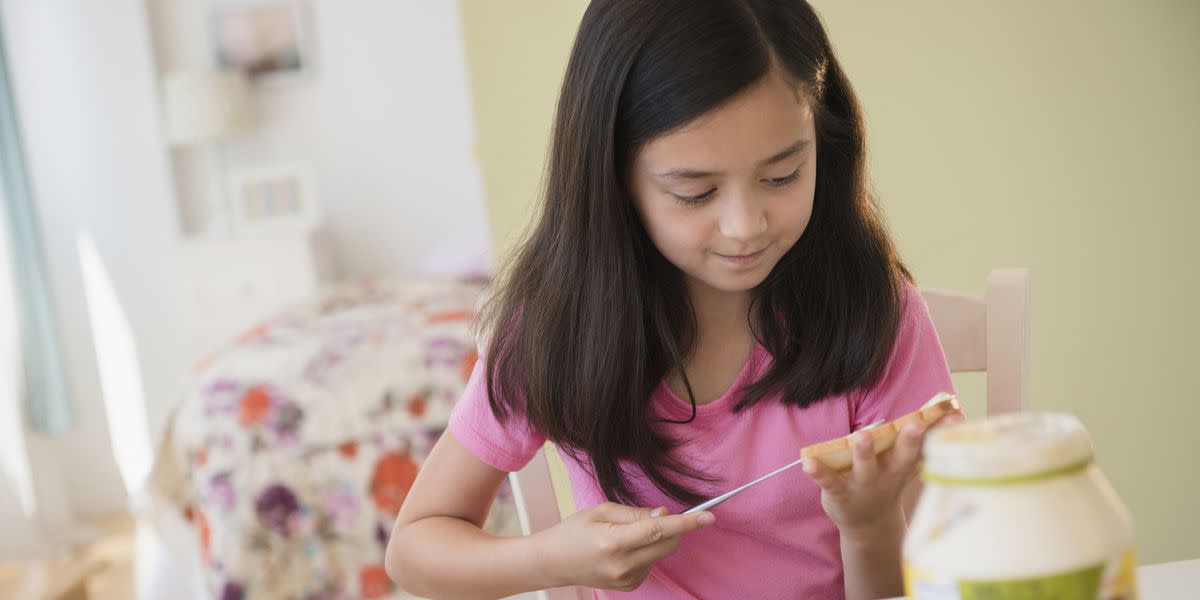Yes, Your Third Grader Should Be Making Their Own School Lunch

In the daily bustle of getting kids ready for school, everyone has a mental checklist of items they have to take care of before getting out the door. Brush teeth? Check. Make sure everyone knows where their shoes are? Check. Make sure you have your phone/wallet/keys? Check, check, check.
The key to making it all go smoothly is to make sure your checklist isn't overflowing with 20,000 items that you, personally, have to keep track of per day. That's why Damon Korb, M.D., a fellow of the American Academy of Pediatrics, suggests that there's at least one task you can take off your list and put back on your kids': making school lunch.
In his book, Raising an Organized Child, Dr. Korb outlines five steps to foster greater independence and help kids get themselves to take on more of their own responsibilities. The steps can be tailored for any age level, and once they start to grasp them, kids can apply them to all different kinds of projects, from keeping their rooms tidy to breaking down and keeping track of a long-term project for school.
"The broad goal of parenting is to prepare kids for launch," Dr. Korb says. "We want to create independent thinkers and problem-solvers, so they can be ready for the real world. If we do everything for them, they never get there." If you help your kids take more ownership over their own lives, you get to step back. "You go from a coach to a manager to a consultant," he says. It's a win/win all around.
And guess what? In helping your kids take on their own lunch-making duties, you'll hit all of Dr. Korb's five steps. He suggests that kids can start tackling this task on their own at around third grade. You might have to set them up at first — show them that they need to have a balanced lunch, and take them through where all of the ingredients are in the pantry — but they can master it if you do these things:
Be consistent. This is more of a guideline for you than your child. "With any rule, boundary, or limit that you create in your family, it only works if you enforce it consistently," he says. "If you make your child's lunch when you're running late, then your child has an incentive to run late."
Introduce order. "The importance of an order is to realize that everything has steps," he says. "There's a beginning, a middle, and an end to every process. Once we understand that, then we can take any task — like making lunch — and break it down into steps." Packing a brown bag doesn't seem as daunting when the process is laid out clearly.
"You don't have to expect perfection right away," he adds. As they get older, you can put a greater emphasis on making sure they follow through to the end of the task — something like making sure they put away all the mess after the lunch is made. Third graders aren't the best at that, Dr. Korb notes, but you'll be setting the stage for them to recognize when they are fully, truly finished when they get bigger.
Give everything a place. You'll all save a little bit of time each morning if you know exactly where the bread is, exactly where the drinks are, and exactly where the snacks are every morning. Those saved seconds add up over time. And once your child gets used to the satisfying feeling of knowing where everything in the kitchen is, you can apply that skill to backpacks, shoes, homework, and important papers that need to be signed.
Practice forward-thinking. This is all the planning and estimating that goes into making lunch. "It's things like, 'Gosh, I'm going to be running a lot today at school. I should probably pack two drinks instead of one,'" Dr. Korb says. It gets kids thinking about the bigger picture. "Even little things, like when a child puts healthy foods in their lunch, they're using their planning skills," he says. "Eating healthy is not immediately rewarding. It's long-term rewarding. We should acknowledge that."
Promote problem-solving. We are all better off in life if we have really sharp problem-solving skills, and it's a great gift to kids to help them develop it as early as possible. For lunch-making, problem-solving is helping them work out kinks, like whether or not they leave themselves enough time to prepare lunch in the morning, or how they can pivot if they realize they're out of necessary ingredient.
These steps build on each other, and you can set lower or higher expectations depending how old they are. "When they're 5 years old, they can be getting ready for bed, putting on their PJs, brushing their teeth, using the bathroom, or picking out their clothes," he says. "Eight and 9-year-olds can be taking baths and making their own lunches, or following homework instructions by themselves. When they're 10 and 12, they can be packing for a trip by themselves. There's all different levels of independence that we can give them at different ages." So it's easier for you in the short term, and much, much better for them in the long run. Now, who wants a PB&J?
('You Might Also Like',)

